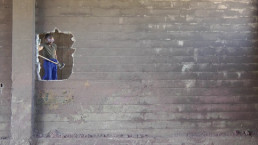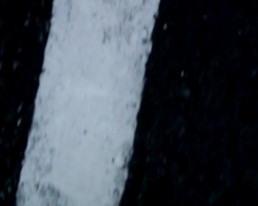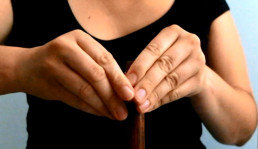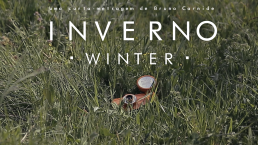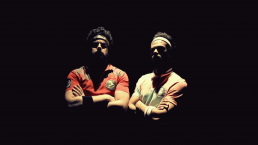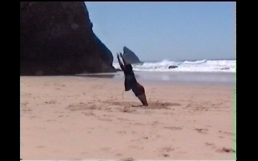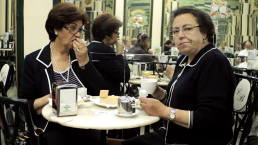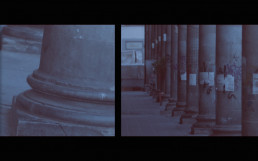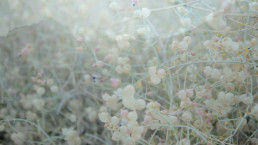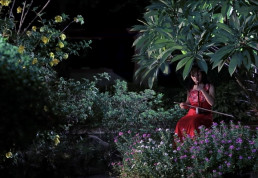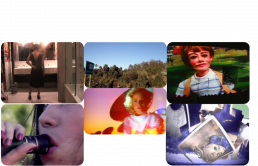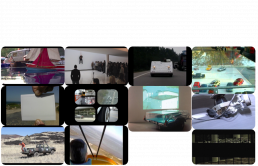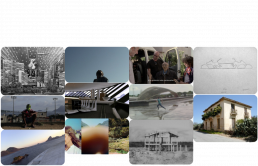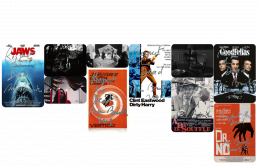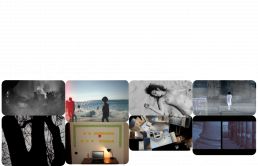26 Agosto, 22h
Praça de Carvão, Museu da Eletricidade
Acting
Curadoria de Jean-François Chougnet
Duração da sessão 90’
O primeiro tema é, naturalmente, ACTING referência irónica ao vídeo acting, estas sessões de desenvolvimento da expressão pessoal praticada no mundo profissional, mas também ACTING no sentido de “jogo” ou “agindo”. Essas contradições semânticas caracterizam bem uma parte importante da produção atual de vídeo apresentada, entre a ação (raramente a militância este ano) e a performance.
Valter Ventura, O Som e a Fúria, 2014, 7’
Contributo para a demolição de uma fábrica desmantelada na antiga CUF (Barreiro).
Catarina Belo, Diluição – Dilution, 2015, 7’10’’
Nesta curta-metragem eu tento ir em busca do significado de humanidade e do eu na sua verdadeira essência.
Faço-o a partir de uma observação distante perante os outros e com um olhar antropológico que tento que se reflita na minha maneira lo-fi de filmar. Também para dar algum senso de humanidade e realidade às filmagens, de forma a que o espectador se identifique com o filme. Isto também se relaciona com o meu texto e o que trata: uma viagem através de pensamentos sobre o mundo em que vivemos que tentam perceber o ser humano, nós próprios e os outros.
Ana Tecedeiro, Amarração, 2015, 2’20’’
O vídeo Amarração faz parte da série de trabalhos, Pequena Coleção de Microgestos, que a artista tem vindo a desenvolver nos últimos anos, explorando o potencial plástico e poético de gestos quotidianos, neste caso a manipulação de elásticos de escritório. A palavra “amarração” designa o ato ou o efeito de amarrar, mas refere-se também a práticas de bruxaria.
Bruno Carnide, Inverno, 2015, 2’30’’
Inverno desenrola-se enquanto uma representação daquilo que a estação fria mata, para depois se recriar novamente.
Maciel Santos & João Cruz, Ping Punk King Pong, 2014, 5’42’’
Prémio do público 2015
Um palco, público, dois jogadores e muita ação. Tudo isto num curto e empolgante jogo de ping pong que acontece numa sala de espetáculo, onde o improvável se torna real e o jogo transforma-se em algo (im)possível.
Ping Punk King Pong é o nome deste vídeo que questiona seriamente mas de forma “cómica” as nossas crenças.
Filipa Nunes, Global Positioning System, 2015, 5’18’’
G.P.S. feito à mão (erros de posicionamento).
Hernani Reis Baptista, Lá Fora, 2013, 5’28’’
Lá fora sugere a dualidade entre dois espaços físicos, o interior e o exterior, como catalisadores de leituras que vão para além da imagem que se apresenta. O título remete para um espaço que se mostra apenas pelo som, enquanto o olhar se depara com uma composição estática, perturbada mais tarde pela inclusão de um terceiro elemento. Os sons exteriores de protesto confrontam-se com as costas voltadas de uma figura virada para a parede, resignadamente acompanhada por um jarro de flores. Uma resignação que se mantém, mesmo quando um cão lhe lambe a cara, inadvertidamente enlevado, igualmente absorto no mesmo espaço interior.
José Simões, Como comem os Portugueses a…, 2014, 10’33’’
Prémio Aquisição FUSO/Fundação EDP 2015
…Torrada em Pão de Forma é o primeiro da série de trabalhos de pesquisa sobre costumes e hábitos dos portugueses. É um retrato social, antropológico, de gerações sobre as diferentes maneiras de como comemos certas gastronomias tradicionais.
De que maneira o fazemos, hábitos antigos e novos, se comemos no princípio ou guardamos para o fim a melhor parte e o porquê de ser assim.
Patrícia Bandeira, Not Otherwise Specified, 2014, 10’
Nos anos 70, seis cidadãos islandeses admitiram envolvimento em dois crimes, apesar de não possuírem memória alguma de terem cometido os mesmos. Perante cenários de coerção digital, química, neuronal ou mesmo ambiental, qual a relação efetiva do indivíduo com o seu núcleo ou tornar-se-á este não-especificado?
Baseado num caso real conhecido como As confissões de Reiquiavique.
Marta Alvim, Reminiscence, 2015, 5’07’’
Um coiote ferido deambula pelo deserto Death Valley. O seu vislumbre e posterior desaparecimento levam a artista a preocupar-se sobre o seu paradeiro. Usando a câmara de filmar como binóculo e instrumento de registo do seu olhar, a artista decide iniciar uma busca do animal pela montanha.
Reminiscence é uma viagem poética sobre a fragilidade da vida e a condição do selvagem. O próximo e o distante, o sonho e a realidade oscilam com leveza espectral num ensaio sobre o tempo, a morte e o amor, sob o presságio de uma vida passada.
José Drummond, Love is the Scariest Thing of All, 2014, 9’01’’
Há uma história, um enredo, uma tensão, uma linha temporal e uma realidade alternativa tanto no amor como na perda. Este trabalho fala sobre a solidão de uma identidade fragmentada, presa ao acontecimento de um amor desperdiçado, confrontando o turbilhão interior, movendo-se através de ilusões, dançando uma intricada coreografia de passado-presente-futuro, fechando os olhos ao arrebatamento atingível através do amor, agitando-se pelos momentos de paixão, dissolvendo-se nos momentos de perda e na sua disjunção de mente-corpo-alma-coração, com camadas e camadas de ambiguidade. O dialeto da falha e da persistência é retratado através de uma possibilidade de vida para além da morte, talvez porque diz respeito às extremidades universais da existência e depende metaforicamente e visualmente sobre os contrastes das emoções em jogo.
Welket Bungué & Miguel Munha, Buôn, 2015, 9’59’’
Buôn é uma exposição de pensamento, desejo viajar e conhecer um mundo para além das paredes de uma cidade que nos encerra social, mental, física, psíquica, política e individualmente nos seus recantos, projetos e arquiteturas.
Guillaume Pazat & Martim Ramos, O Castigo, 2014, 2’45’’
«C’est qu’en vérité le chemin importe peu, la volonté d’arriver suffit à tout.» Albert Camus, O mito de Sísifo
Quando o primeiro homem percebeu que, com a ajuda de outros homens, faria mais e melhor, as coisas não voltariam a ser como dantes. Nasceram as cidades e o caminho da água determinava o caminho dos homens. Hoje, as grandes metrópoles em que tudo é vertical e tudo cresce para longe do chão, geram renegados, excluídos, revoltados que, como o primeiro homem, procuram o caminho das coisas elementares. São os novos e os velhos, os sem teto, os desempregados e os empregados, os pobres, os sem remédio e os remediados que ocupam o que as cidades abandonaram, os que lutam pelo seu espaço e os que lutam para que a água chegue ao canto a que chamam casa. Aqui, no centro de São Paulo, um homem carrega diariamente água às costas, ao longo das escadas de um prédio devoluto.
August 26, 10pm
Praça de Carvão, Museu da Eletricidade
Acting
Curatorship by Jean-François Chougnet
Total running time 90’
The first theme is, of course, ACTING, ironic reference to video acting: development sessions of personal expression practiced in the professional world, but also ACTING meaning “play” or “act”. These semantic contradictions characterize a major part of the current video production presented, between action (rarely militancy this year) and performance.
Valter Ventura, O Som e a Fúria, 2014, 7’
Contribution to the demolition of a dismantled factory at the former CUF (Barreiro).
Catarina Belo, Diluição – Dilution, 2015, 7’10’’
In this short film I try to find the meaning of humanity and the self in their true essence.
I do it by a distant observation from others and with an anthropologic look that I tried to reflect in my lo-fi way of filming. Also, to give a sense of humanity and reality to the footage, in order to invite the spectator to feel connected with the film. This is also related to my words and its subject: a journey on the thinking of the world we live in, which attempt to understand the human being, ourselves and others.
Ana Tecedeiro, Amarração (Binding), 2015, 2’20’’
This video is part of the work series A Small Collection of Micro Gestures, which the artist has been developing in recent years, exploring the visual and poetic potential of everyday gestures, in this case the handling of rubber bands.
The word “Amarração (Binding)” means the act or effect of tying, but also refers to witchcraft practices.
Bruno Carnide, Inverno (Winter), 2015, 2’30’’
Winter is a simple role-playing of what the cold season kills, in order to be rebuilt again.
Maciel Santos & João Cruz, Ping Punk King Pong, 2014, 5’42’’
Public Prize 2015
A stage, an audience, two players and a lot of action. All this in a short and exciting ping pong game which takes place in a theater where the improbable becomes real and the game becomes something (im)possible.
Ping Punk King Pong is the name of this video that make serious questions about our beliefs but in a “comic” way.
Filipa Nunes, Global Positioning System, 2015, 5’18’’
Handmade G.P.S. (mapping errors).
Hernani Reis Baptista, Lá Fora (Outside), 2013, 5’28’’
Lá fora (Outside) suggests the duality between two physical spaces, interior and exterior, serving as catalysts for readings that go beyond the image that is presented. The title refers to a space shown only by sound, while the viewer is faced with a static composition, later disturbed by the appearance of a third element. The outside sounds of protest are confronted with the back of a figure facing the wall, resignedly accompanied by a vase of flowers. A resignation that is maintained even when a dog licks his face, inadvertently ecstatic, equally absorbed in the same interior space.
José Simões, Como comem os Portugueses a… (How the Portuguese Eat…), 2014, 10’33’’
FUSO/EDP Foundation 2015 Acquisition Award
“…White Bread Toast”(Torrada em Pão de Forma) is the first of a research on a video work series about Portuguese manners and habits. It’s a social and anthropological generational portrait about the different ways on how we eat certain traditional gastronomy.
In what way we do, old and new habits, if we eat at the beginning or we keep the best part to the end and why it is so.
Patrícia Bandeira, Not Otherwise Specified, 2014, 10’
In the 70’s, six Icelandic citizens plead guilty in two crimes, although they didn’t remember anything about the cases. When facing scenarios of digital, chemical, neuronal or even environmental manipulation and coercion, what is the effective relation of the individual with his core or does it turn out to be not-specified?
Based in a real case known as The Reykjavik Confessions.
Marta Alvim, Reminiscence, 2015, 5’07’’
A wounded coyote wanders through the Death Valley desert. This sighting and the animal’s subsequent disappearance cause the author to wonder what might have become of it. Using her camera as binoculars and as a way of recording the movement and the focus of her gaze, she sets off on a quest in the mountain to uncover the fragility of life and the condition of the wild.
In this very personal film, the author’s thoughts go along with footage recorded during this search. The near and the distant, dream and reality oscillate with spectral levity, playing with death and time, in a poetic narrative that speaks about intuition, memory and affection.
José Drummond, Love is the Scariest Thing of All, 2014, 9’01’’
There is a storyline, a plot, a tension, a timeline and an alternative reality in love and loss. This work speaks about the loneliness of a fragmented identity, trapped on a wasted love event, confronting the inner whirlwind, moving in and out through illusions, dancing the intricate choreography of past-present-future, closing the eyes to the rapture attainable through love, stirred by moments of passion, dissolving by moments of loss and its disjuncture of mind-body-heart-soul, with layers and layers of ambiguity. The dialect of failure and persistence is portrayed on a possibility of afterlife perhaps because it concerns the universal extremities of existence and it depends metaphorically and visually upon the stark contrasts of the emotions played.
Welket Bungué & Miguel Munha, Buôn, 2015, 9’59’’
Buôn is an expression of thinking, a desire to travel and see a world beyond the walls of a city that closes us socially, mentally, physically, psychologically, politically and individually in its places, projects and architectures.
Guillaume Pazat & Martim Ramos, O Castigo, 2014, 2’45’’
«C’est qu’en vérité le chemin importe peu, la volonté d’arriver suffit à tout.» Albert Camus, The Myth of Sisyphus
When the first man realized that, with the help of other men, he could do more things and better, nothing would never be the same as it was before. Cities were born, and the path of water determined the path of men. In today’s major metropolises where everything is vertical and everything rises far above the ground, outcasts and misfits are created, who, like the first man, are on the look for the path of elemental things. They are the young and the elderly, the homeless, the unemployed, the employed, the poor, the well-to-do and the not well-to-do, who occupy what the cities have left behind, who fight for their space, and who struggle to bring water to whatever spot they have called home. Here in the centre of São Paulo, a man carries water on his shoulders on daily basis through the stairs of an abandoned building.
